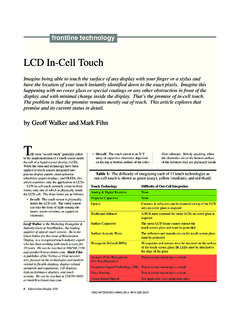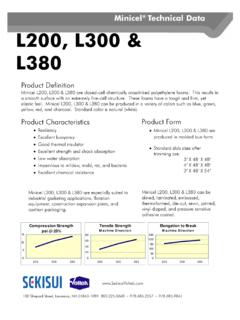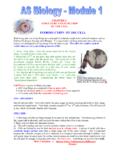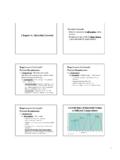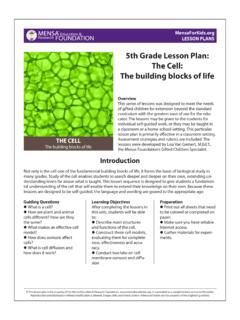Transcription of Cell Isolation Optimizing System - Worthington …
1 Worthington Biochemical CorporationTel: Fax: Isolation Optimizing SystemKit contains an assortment of the enzymes most frequenty used for tissue dissociation and primary cell Isolation applications and a Cell Isolation Guide which provides information on theory, techniques and lists hundreds of references according to tissue and at 2 - 8 CWorthington Biochemical Corporation Lakewood, New Jersey Fax: Isolation Optimizing SYSTEM1 Introduction ..1 Cell Isolation Theory Tissue Types ..2 Dissociating Enzymes ..2 Cell Isolation Techniques (using the kit) Methods and Materials ..5 Working with Enzymes Media Table Equilibration of Media Tituration Cell Harvesting Trypsinization Optimization Techniques ..7 General Guidelines Optimization Strategy Cell Quantitation Measure of ViabilityGeneral References ..10 Tissue Tables ..11-39 Collagenase Sampling Program ..40 Related Worthington Products ..41 IntroductionTissue dissociation/primary cell Isolation and cell harvesting are principal applications for enzymes in tissue culture research and cell biology studies.
2 Despite the widespread use of enzymes for these applications over the years, their mechanisms of action in dissociation and harvesting are not well understood. As a result, the choice of one technique over another is often arbitrary and based more on past experience than on an understanding of why the method works and what modifications could lead to even better goal of a cell Isolation procedure is to maximize the yield of functionally viable, dissociated cells , and there are nine primary parameters which affect the outcome of any particular procedure:1. Type of tissue2. Species of origin3. Age of the animal4. Dissociation medium used5. Enzyme(s) used6. Impurities in any crude enzyme preparation used7. Concentration(s) of enzyme(s) used8. Temperature9. Incubation timesThe first three items generally are not a matter of choice. To achieve suitable results the other variable conditions are best defined empirically. Researchers searching the scientific literature for information on the ideal enzymes and optimal conditions for tissue dissociation are often confronted with conflicting data.
3 Much of the variation stems from the complex and dynamic nature of the extracellular matrix and from the historical use of relatively crude, undefined enzyme preparations for cell Isolation applications. The extracellular matrix is composed of a wide variety of proteins, glycoproteins, lipids and glycolipids, all of which can differ in abundance from species to species, tissue to tissue and with developmental age. Furthermore, commonly used crude enzyme preparations such as Pronase, NF 1:250 and collagenase contain several proteases in variable concentrations, as well as a variety of polysaccharidases, nucleases and guide summarizes our knowledge of how these enzymes accomplish the routine operations of tissue dissociation and cell harvesting, describes standard lab procedures; offers a logical experimental approach for establishing a cell Isolation protocol, and lists many tissue-specific : We have not limited the references listed to only those papers using Worthington enzymes.
4 Generally speaking, the enzymes supplied in this kit can be used interchangeably for most preparations Isolation Optimizing SystemEnzyme Code* Qty/Vial Page # Collagenase Type 1 CLS1 500 mg dw ..3 Collagenase Type 2 CLS2 500 mg dw ..3 Collagenase Type 3 CLS3 500 mg dw ..3 Collagenase Type 4 CLS4 500 mg dw ..3 Trypsin TRL 500 mg dw ..4 Hyaluronidase HSE 50,000 Units ..4 Elastase ESL 100 mg P ..4 Papain PAPL 100 mg P ..4 Deoxyribonuclease I DP 25 mg dw ..5 Neutral Protease (Dispase ) NPRO 10 mg dw ..5 Trypsin Inhibitor SIC 100 mg dw ..5 dw = dry weight P = protein * The code which appears in the table for each of the enzymes corresponds to the codes found in our regular price list. Kit ContentsWorthington Biochemical Corporation Lakewood, New Jersey Fax: Isolation Optimizing SYSTEM2 Cell Isolation TheoryTissue Types This section summarizes the general characteristics of extracellular matrices associated with various types of tissue. Coupled with the descriptions of individual enzymes offered in the next section, this information will aid in choosing the enzyme(s) best suited for a particular TissueIn the adult, epithelium forms tissues such as the epidermis, the glandular appendages of skin, the outer layer of the cornea, the lining of the alimentary and reproductive tracts, peritoneal and serous cavities, and blood and lymph vessels (where it is usually referred to as endothelium ).
5 Structures derived from outpouchings from the primitive gut, including portions of the liver, pancreas, pituitary, gastric and intestinal glands are also composed of epithelial cells are typically packed so closely together that there is very little intercellular material between them. An extremely tight bond exists between adjacent cells making dissociation of epithelium a difficult the lateral surfaces of adjacent epithelial cells there are four distinct types of intercellular bonds: the zonula occludens, zonula adherens, macula adherens and nexus. The former three are often closely associated to form a junctional complex. In the zonula occludens, or tight junction , there are multiple sites of actual fusion of the adjacent unit membranes interspersed by short regions of unit membrane separation of approximately 100-150 . In a zonula adherens, or intermediate junction , a fine network of cytoplasmic filaments radiates from the cell membrane into the cytoplasm.
6 The space between unit membranes of adjacent cells is approximately 150-200 and is composed of an intercellular amorphous substance of unknown composition. In the macula adherens, or desmosome , there is a somewhat similar array of intracellular filaments. The adjacent unit membrane space is approximately 150-200 and consists of an extracellular protein and glycoprotein ground substance, often with an electron-dense bar visible within it. The integrity of the desmosome requires calcium, and it is broken down by EDTA and calcium-free media. The enzymes collagenase, trypsin and hyaluronidase can also dissociate the desmosome. The nexus, or gap junction , covers most of the epithelial cell surface. In these areas, the unit membranes appear tightly attached and are separated by only 20 . The intercellular material consists of an amorphous, darkly-staining the basal surface of the epithelium where it overlays connective tissue, there is an extracellular bonding layer or sheet called the basal lamina.
7 The lamina is composed of a network of fine, collagen-like reticular fibers embedded in an amorphous matrix of high and low molecular weight TissueConnective tissue develops from mesenchymal cells and forms the dermis of skin, the capsules and stroma of several organs, the sheaths of neural and muscular cells and bundles, mucous and serous membranes, cartilage, bone, tendons, ligaments and adipose tissue is composed of cells and extracellular fibers embedded in an amorphous ground substance and is classified as loose or dense, depending upon the relative abundance of the fibers. The cells , which may be either fixed or wandering, include fibroblasts, adipocytes, histiocytes, lymphocytes, monocytes, eosinophils, neutrophils, macrophages, mast cells , and mesenchymal are three types of fibers: collagenous, reticular, and elastic, although there is evidence that the former two may simply be different morphological forms of the same basic protein.
8 The proportion of cells , fibers and ground substance varies greatly in different tissues and changes markedly during the course of fibers are present in varying concentrations in virtually all connective tissues. Measuring 1-10 m in thickness, they are unbranched and often wavy, and contain repeating transverse bands at regular intervals. Biochemically, native collagen is a major fibrous component of animal extracellular connective tissue; skin, tendon, blood vessels, bone, etc. In brief, collagen consists of fibrils composed of laterally aggregated polarized tropocollagen molecules ( 300,000). Each rod-like tropocollagen unit consists of three helical polypeptide -chains wound around a single axis. The strands have repetitive glycine residues at every third position and an abundance of proline and hydroxyproline. The amino acid sequence is characteristic of the tissue of origin. Tropocollagen units combine uniformly in a lateral arrangement reflecting charged and uncharged amino acids along the molecule, thus creating an axially repeating periodicity.
9 Fibroblasts and possibly other mesenchymal cells synthesize the tropocollagen subunits and release them into the extracellular matrix where they undergo enzymatic processing and aggregation into nativecollagen fibers. Interchain cross-linking of hydroxyprolyl residues stabilizes the collagen complex and makes it more insoluble and resistant to hydrolytic attack by most proteases. The abundance of collagen fibers and the degree of cross-linking tend to increase with advancing age, making cell Isolation more fibers form a delicate branching network in loose connective tissue. They exhibit a regular, repeating subunit structure similar to collagen and may be a morphological variant of the typical collagen fibers described above. Reticular fibers tend to be more prevalent in tissues of younger fibers are less abundant than the collagen varieties. They are similar to reticular fibers in that they form branching networks in connective tissues.
10 Individual fibers are usually less than 1 m thick and exhibit no transverse periodicity. The fibers contain longitudinally-arranged bundles of microfibrils embedded in an amorphous substance called elastin. Like collagen, elastin contains high concentrations of glycine and proline, but in contrast has a high content of valine and two unusual amino acids, desmosine and isodesmosine. Fibroblasts and possibly other mesenchymal cells synthesize the elastin precursor, tropoelastin, and release it into the extracellular matrix where enzymes convert the lysine residues into the desmosines. Polymerization of elastin occurs during interchain cross-linking of the latter. In this state, elastin is very stable and also highly resistant to hydrolytic attack by most viscous extracellular ground substance in which connective tissue cells and fibers are embedded is a complex mixture of various glycoproteins, the most common being hyaluronic acid, chondroitin sulfate A, B, and C and keratin sulfate.

